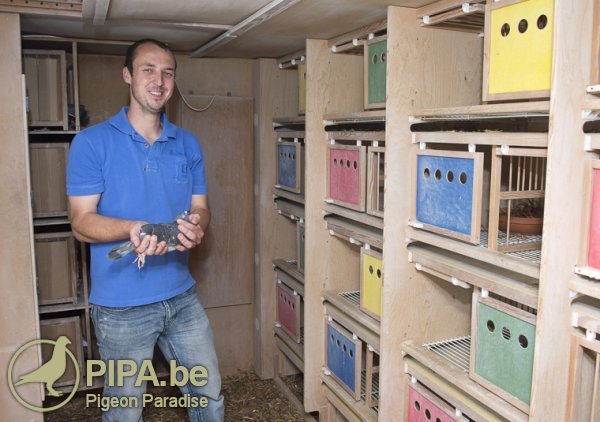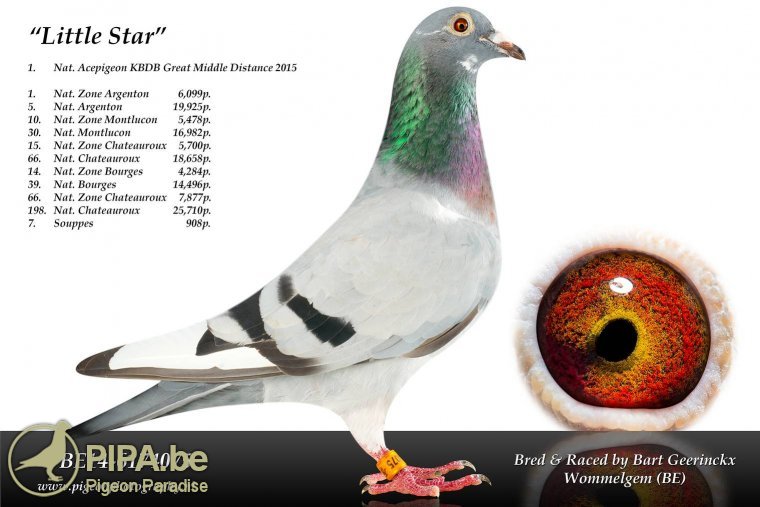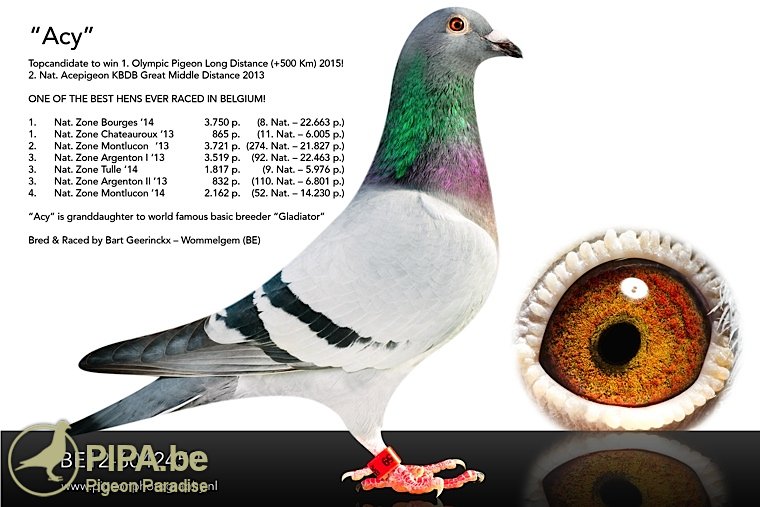In the beginning of 2012 Bart Geerinckx faced a tremendous challenge. His father Luc passed away from a fatal disease, a devastating event for the family. His passing also raised questions about the future of his pigeon loft, as Bart and his companion were suddenly left on their own. They could no longer turn to their mentor and right hand man Luc. Keep in mind it takes a lot of time and dedication to run a top class pigeon loft. This is a particularly difficult task if you have to combine it with a fulltime job, and Bart was forced to decide between his job and his hobby. He had a good talk with his employer, and he eventually decided to take the leap: he would become a fulltime pigeon fancier. His employer promised that he could return to his old job should he fail to succeed in pigeon racing.
Bart could now put all his energy in this project. He was determined to continue the life’s work of his father Luc but he was also determined to reach his goals: to make the Geerinckx breed a nationally renowned pigeon family in the longer middle distance and the light long distance. He has clearly managed to achieve that goal indeed!
A phenomenal start with a super class breed
Bart and Jurgen achieved a great result already in 2012, finishing off a splendid season with a national victory from Argenton against 12,390 pigeons, along with the title of 1st Olympiad Pigeon Allround in Nitra! Their results in the following season were even more impressive: they were again victorious in Argenton, this time winning both a 1st and 2nd national against 16,363 old birds. In other words they managed to win a national first prize in two consecutive seasons. A job well done!
The two fanciers were in great form in 2014 as well, winning two national first prizes in the zone and a provincial first prize that year. They also represented Belgium in the Budapest Olympiad in January 2015 with Acy (1st Olympiad Pigeon Category C) andSweety (2nd Olympiad Pigeon Category B).
Their biggest achievement so far came in 2015, when they won the title of 1st National Ace Pigeon Longer Middle Distance Yearlings KBDB with Little Star, which also won the PIPA ranking title of Best Yearling of Belgium over 5 national longer middle distance races.
Bart Geerinckx had an impressive career start and we thought it was time to take a look behind the scenes at the Geerinckx pigeon family. How did he get so successful? He did not hesitate to share his approach and his success formula with PIPA.
A conversation with Bart Geerinckx
PIPA: Bart, Luc left you with a magnificent collection of pigeons, and a perfectly set up racing and breeding loft. This super class Geerinckx pigeon breed became a nationally renowned pigeon family. What strategies did you use to try and maintain, or even improve the level of quality in this breed?
Bart: If you read reports about national champions that have managed to perform at the highest level for for many years, you will often come across the same idea: you should never sell the foundation of your pigeon family, only the pigeons that come from it. We have always kept this in mind, and we haver never sold our best pigeons. Not in the past and not in the future. They are crucial for the further development of your breed. We only sell some of our descendants from time to time, for which I work exclusively with PIPA.
PIPA: What strategy do you use to breed even better pigeons, and to further improve your existing breed?
Bart: We have always stuck with the idea of pairing top quality with top quality. Today the demands are even higher, so we pair super class with super class, and it takes some really talented pigeons to do this. Pigeons that can make a difference, that stand out from the others. Our Gladiator is a good example, just like Willyke (who bred outstanding pigeons with different cocks), Sylvester, Blauwe Yzeren and Witpen Wouters. We hope Blue Lagoon (the dam of Little Star) will develop into an equally valuable breeding dam in the future.
PIPA: Inbreeding or crossing?
Bart: We do not use inbreeding too often, I think it makes more sense to just focus on good quality breeding lines. Sometimes a certain stock breeder will appear more than once in the pedigree of a Geerinkx pigeon, but this is mostly the result of breeding youngsters along a given bloodline. We do not work with very close pairings like father with daughter, brother with sister, etc.
Pairing super class pigeons is usually a more successful approach: you just know that these pigeons have something more to offer. They have what it takes to win prizes and to stand out in the crowd. The goal should be to carry over these characteristics to future generations.
PIPA: This appears to be working really well.
Bart: Well, you don’t always get what you want. Even the super class breeders will sometimes breed lower quality youngsters. Still, a proven breeder has a much greater chance of breeding a new champion. The question I ask myself is: where do you find the marginal gains that make up the difference between winning and losing a race? The answer is always to breed youngsters from super class pigeons. This is why we will never get rid of our proven breeders. They have what it takes. I focus on top quality birds!
PIPA: We assume even the Geerinckx breed needs reinforcements every once in a while?
Bart: Correct. And we tend to focus on super class pigeons when it comes to reinforcements as well. I will often take a chance when the oppurtunity arises. The investments we made in New Freddy is a good example. I think he is really an exceptional pigeon, especially when you look at the distance he covered and the racing conditions during his best races: he won most of his top prizes in a strong headwind and in a disadvantageous location. He combines strength, power, and orientation. These are the qualities I am looking for.
PIPA: And then you make a selection based on the results?
Bart: Exactly. The first step is to try and breed super quality pigeons but caretaking is crucial as well if you want to get the most out of them. You have to come full circle.
Focused on the old birds’ competition
PIPA: What does the racing team for 2016 look like?
Bart: The team consists of 37 racing hens (11 old birds and 26 yearlings) and 47 cocks (18 old birds and 29 yearlings). We focus primarily on the races of 500 to 600km, although we also plan to basket some of our pigeons for Limoges, Jarnac, Brive and Tulle in July.
PIPA: Do you use classic or total widowhood, or a combination of both?
Bart: Our entire team races in classic widowhood, which means the partners stay home. This means you have to provide more space and it involves additional caretaking as well. Still, I think it is worth the effort, especially because our best results were won in classic widowhood. So we stick with it.
PIPA: We have already had the first preparatory sprint races of 2016. How did the preparation for this season go?
Bart: We have a different approach for the hens and the cocks. I suggest we talk about thens first.
PIPA: Very well. You told us this winter that you were going for a slightly different approach.
Bart: Yes, it can be very useful to make some changes from time to time. I see it as a way to try and finetune our existing approach, and to be on top of our game in the crucial races, which are of course the national classics.
PIPA: Could you elaborate?
Bart: The goal is now to get the racing hens in widowhood by the start of the first middle distance race in early May. They were paired around the 10th of March and they could raise one youngster. They had to raise the youngster on their own when it was ten days old, to prevent the cocks from chasing after the hens, possibly resulting in a second egg. The pigeons can get very angry not only because they want to defend their youngster, but also their territory. This approach prevents the pigeons from pairing with each other in the buildup phase, and it also helps them to get motivated for the races from Quiévrain and Noyon, which are important training flights for the national classics. These classics are the most important races of the season and we want our pigeons to be in great form by then, in widowhood! The youngster is taken away when the hens are basketed for the first middle distance race. When they arrive home the cock will be waiting for them, and widowhood begins.
PIPA: What does the preparation look like before the pairing on the 10th of March? Have they had their first training flights at home by then?
Bart: First of all: our young birds are basketed very often, but they will never do more than a shorter middle distance race. A national race is out of the question. In fact, most of our young birds will only compete in the sprint races, with a race from Noyon on Sunday and a midweek race from Quiévrain (100km).
During the winter I try to make sure the pigeons start training in time, with some preparatory flights around the loft, depending on the weather of course. The goal is to make sure the pigeons can gradually gain some basic fitness, which I think is very important.
PIPA: What does that mean to you, basic fitness?
Bart: Well, the pigeons can start to fly for an hour straight, or even an hour and a half. But nothing too demanding! I do not believe in training very hard during the winter. In fact, I learned from experience that a pigeon with some good basic fitness before the season will find it much easier to really get in great shape during the racing season. They also tend to stay fit for a longer period of time. I think this approach has nothing but benefits.
Our main topics in part 2 will be training and recovery.



